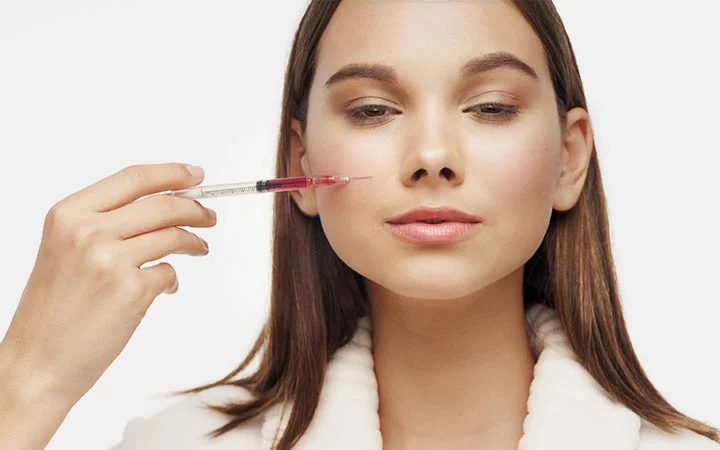The number of Botox (bacterium clostridium botulinum) units utilized during treatments may differ depending on the patient. Units are tailored for each patient depending on their gender, treatment area, facial muscle strength, and any other aspects that might affect the amount of Botox needed.
To achieve the best results, Botox must be injected precisely into the correct injection sites, as with many other cosmetic procedures, to achieve the best benefits. Effective therapy can result in a younger-looking appearance, but only the proper injection location and dose can be used by the injection specialist or cosmetic surgeon.
Botox is most commonly used to treat the forehead, crow's feet, and frown lines. Botox will always be measured in units, regardless of where you obtain it.
How many Botox units for each specific area?
Forehead
Depending on the size of the forehead and how much movement is required, 5-15 units of Botox are prescribed to repair fine wrinkles on the forehead.
Some practitioners claim to inject 10 to 30 units on average. The producer of Botox Cosmetic, Allergan, recommends a dose of 4 units each in five areas on the forehead for a total of 20 units.
Between Eyebrows
In between the brows, 15-20 units of Botox are indicated on average.
Brow Furrow
Furrowed brows can be reduced with 15-20 units of Botox.
Eyebrow Lift
The brow can be lifted by injecting 10-15 units of Botox into the crow's feet on the side of the eyes. Many people believe that injecting Botox in the forehead lifts the brow; however, that isn't the case.
Botox injections in the forehead immobilize its muscles for a short period. Because the forehead muscle's purpose is to elevate the brows, paralyzing it lowers the brows
Botox injections under the brow and around the crow's feet of the eye, on the other hand, raise the brow. Crow's feet are caused by a muscle that pushes the brow down. The orbicularis oculi muscle, which surrounds the eye, can be paralyzed to assist in lifting the brow.
Face
The amount of Botox needed to repair facial wrinkles depends on which areas are treated and the injection sites.
Cheeks
Botox is not applied in the cheeks. Many specialists advise using dermal fillers to make the cheeks look fuller.
Glabellar Lines
Doctors prescribe 15-20 units to reduce glabellar lines.
Lips
Botox can be used to soften kiss lines in the lips. However, because that muscle (orbicularis oris) is momentarily weakened, drinking using a straw becomes difficult. As a result, many specialists prescribe that lines around the mouth be treated with lasers or superficial fillers.
Gummy Smile
On each side, 2.5 units are advised. This is prescribed for people whose gums are visible when they smile. Botox relaxes the muscle, resulting in a grin with only teeth.
Crow’s Feet
To reduce the appearance of crow's feet, the average amount is roughly 10 units on each side.
Eyes
10 units should be carefully placed in various injection locations on each side.
Frown Lines
Frown lines (Lateral Canthal Lines) are usually measured in units of 15-20. To repair these lines, additional units are required due to their strength. More units may be necessary for some people.
Bunny Lines
10 units on each side are advised for Bunny Lines. Because the muscle looks like a fan, therapy must hit the entire muscle, anything less will not produce the intended impact.
Marionette Lines
Marionette lines are not treated with Botox. Botox is a drug for relieving muscle tension and only lasts for a short period. To fill up volume loss and mask the depression, fillers can be injected in front of the marionette lines.
Smoker's Lines
Many physicians prescribe utilizing lasers or superficial fillers, as they do with the lips, to help with fine wrinkles around the mouth.
Neck
As you become older, the platysmal bands may become more prominent. To check yours, make an exaggerated E sound with your mouth and look for two lines on your neck. The muscle protrudes when it is engaged. Injecting Botox helps suck in the muscle and make it appear tight. Doctors advise getting anywhere from 20 to 60 units.
Masseter Muscle
Patients who grind or clench their teeth activate the masseter muscle. This might be the result of stress or a negative habit. This can cause jaw pain, temporomandibular joint dysfunction (TMJ), or a wide appearance at the bottom area of the face. Doctors often prescribe injecting 15-20 units on each side, which can help to slim down the face while also providing functional comfort by combating the symptoms of teeth grinding and clenching.
Contact us to book a free consultation
It's important to remember that the outcome of Botox treatments differs from person to person. It's vital to discuss your expectations with your doctor before having a Botox procedure to decide what would work best for you.
To book your free consultation and help you figure out your next move, call Aesthetique Med Spa in Oakdale, MN, at (612) 361-6691 or contact us online.


